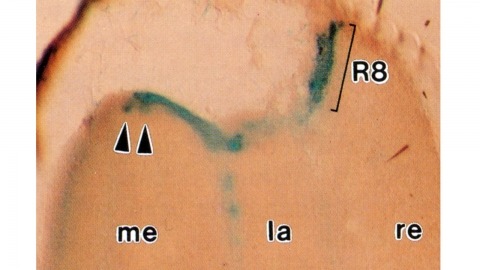Filter
Publication Date
Type of Publication
2 Publications
Showing 1-2 of 2 resultsHistological staining of wild-type and sevenless transgenic Drosophila melanogaster bearing Rh3-lacZ fusion genes permits the selective visualization of polarization-sensitive R7 and R8 photoreceptor cells located along the dorsal anterior eye margin. Diffusion of beta-galactosidase throughout these cells reveals that they project long axons to the two most peripheral synaptic target rows of the dorsal posterior medulla, defining a specialized marginal zone of this optic lobe. Comparison of the staining patterns of marginal and nonmarginal Rh3-lacZ-expressing photoreceptor cells in the same histological preparations suggest that the marginal cells possess morphologically specialized axons and synaptic terminals. These findings are discussed with reference to the neuroanatomy of the corresponding dorsal marginal eye and optic lobe regions of the larger dipterans Musca and Calliphora, and in relation to the ability of Drosophila to orient to polarized light.
The expression of GABA is restricted to the progeny of only six of the 24 identified postembryonic lineages in the thoracic ganglia of the tobacco hornworm, Manduca sexta (Witten and Truman, 1991). It is colocalized with a peptide similar to molluscan small cardioactive peptide B (SCPB) in some of the neurons in two of the six lineages. By combining chemical ablation of the neuroblasts at specific larval stages with birth dating of the progeny, we tested whether the expression of GABA and the SCPB-like peptide was determined strictly by cell lineage or involved cellular interactions among the members of individual clonal groups. Chemical ablation of the six specific neuroblasts that produced the GABA-positive neurons (E, K, M, N, T, and X) or of the two that produced the GABA + SCPB-like-immunoreactive neurons (K, M) prior to the generation of their lineages resulted in the loss of these immunoreactivities. These results suggest that regulation between lineages did not occur. Ablation of the K and M neuroblasts after they had produced a small portion of their lineages had no effect on the expression of GABA, but did affect the pattern of the SCPB-like immunoreactivity. Combining birth-dating techniques with transmitter immunocytochemistry revealed that it was the position in the birth order and not interactions among the clonally related neurons that influenced the peptidergic phenotype. These results suggest that cell lineage is involved in establishing the GABAergic phenotype and that both cell lineage and birth order influence the determination of the peptidergic phenotype.(ABSTRACT TRUNCATED AT 250 WORDS)

